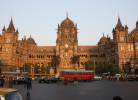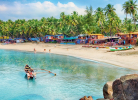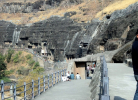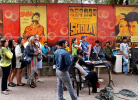Shri Swaminarayan Mandir Mumbai
Visitor Information:

-
Famous For Religious, Worship
-
Fee Guide in Detailed Below
-
Visiting Time 6 am to 12 pm and 4 pm to 9:15 pm
-
Duration of Visit NA
Shri Swaminarayan Mandir is more than a century-old Hindu religious site holding Laxminarayan Dev (Lord Vishnu) and Gaulokvihari (Lord Lakshmi) as the main deity. This temple is not just an important pilgrimage site for Hindu. It has also altered the culture of the region in many ways.
Do you know that the flower market closer to the temple, Phool Galli started because of the huge demand of flowers in this region by a few temples in the region along with Shri Swaminarayan Mandir? Hindus offer flowers tied as a garland as a main offering to deities.
History of Shri Swaminarayan Mandir
This temple has been a part of Mumbai since 1868. RanchhoddasPranjeevandas, a pious man demolished and re-built his own residence to create a temple. He installed three deities namely Hari Krishna Maharaj, Radhika, and Gaulokvihari.
Later, in 1903, the current structure of the temple was built and two more deities were included namely Lakshminarayan Dev and Ghanshyam Maharaj.
Architecture of Shri Swaminarayan Mandir
The three spire structure is easily notable from around the temple. The temple structure starts with 25 steps leading to a large audience hall, where you can find statues of Lord Ganesh and Lord Hanuman.
In the far end of the hall, you will find three shrines for GhanashyamMaharaj, Narayan, and Laxmi. To the center, you will find the main shrine with a large deity.
On the walls of the temple, you can find many paintings related to the childhood and stories of Krishna.
Tourist Attractions in Shri Swaminarayan Mandir
There are more than 109 caves in this collection which were used between the 1st century BC and 11th century AD. Interestingly, almost all the caves have a small plinth made entirely with stone. It is assumed that the plinth was used as a bed.
Many caves hold large congregation hall supported by mammoth pillars. These are Buddhist shrines, which were used for religious and spiritual purposes. The caves, which were used as monasteries have beautiful reliefs of Bodhisattvas and Buddha.
Among the 109 caves, here are the top caves of importance.
- Enjoy the carved interior structure and paintings on the walls of the temple.
- Visiting during ritual times to enjoy interesting colorful rituals.
- The dome of the temple holds many paintings with intricate details.
- If you visit during any special ritual, you can enjoy delicacies here.
- There are numerous attractions close to the temple like Five gardens, Shivaji Park, BB Dadar market, Matunga market, and others.
Festivals
Top festivals to enjoy in this temple are:
- Ram Navami
- Swaminarayan Jayanthi
- Janmashtami
- Ganesh Chaturthi
- Mahashivratri
- Hindola
- Vaman Jayanti, and others
Any festival related to Lord Vishnu is celebrated with cheer in this shrine. Apart from this, you can find many religious activities every month.
- First Sunday of every month – A mahashaba is conducted where religious hymns are sung and religious lectures will be conducted.
- Every Sunday from 9 am to 11 am – Baldhun Mandal is conducted where religious preaching, spiritual activities, and programs are conducted for children.
Entry Fee of Shri Swaminarayan Mandir
No entry fee for the temple. However, if you are wishing to perform rituals, special tokens have to be brought for specific rates. Apart from these, people donate money to the temple and it is not a compulsory act.
Visiting Timing of Shri Swaminarayan Mandir
The temple is open for tourists and pilgrims from 6 am to 12 pm and from 4 pm to 9:15 pm. The temple is open throughout the year.
How To Reach Kanheri Caves
This temple is located in the Bhuleshwar region of Mumbai city. Once you are inside the city, you can find buses, cabs, and local trains to the temple from any part of the city.
If you are traveling to Mumbai, Mumbai is well connected with all major parts of the country and many important international destinations.
Mumbai holds an international airport that connects the city with all major cities of the country and many international destinations. The airport is just 21 km away from the temple.
Mumbai railway station is one of the busy railway stations of the country connecting it with almost all the states.
You can find government buses, luxury coaches and cabs from various parts of the country to Mumbai. The availability and cost of these services vary with time (more buses during the tourism season).
Nearest train stations:
- Mumbai Central railway station – 1.68 km away from the temple
- Mahalakshmi railway station – 2.77 km away from the temple
From the station, you can find cabs and buses to reach the temple.
Also Read : How to Reach Mumbai
Best Time To Visit Shri Swaminarayan Mandir
The best time to visit the temple is during any festivals. Within a day, it is best to visit during any religious ritual.
- Mangla Aarti – 6 am
- Darshan Badh – 6:30 – 7:45 am
- Shangar Aarti- 7:45 am
- Darshan Badh – 10:30 – 11 am
- Rajbhog Aarti – 11 am
- Darshan Badh – 12 pm
- Uthapan Darshan – 4 pm
- Sandhya Aarti – 7 pm
- Darshan Bandh – 7:45 pm
- Shayan Aarti – 9 pm
- Darshan Bandh – 9:15 pm
If you are looking for the right climatic condition, it is best to visit the temple during the winter season. Winter starts in October and ends in February. This season has a calm and pleasing climate allowing you to enjoy sightseeing with ease.
Monsoon brings tremendous rainfall to Mumbai and thus, it is best to avoid it. Rains start from July and ends in September.
Summers are hot, humid and de-hydrating. Thus, if you cannot withstand Indian heat, it is best to skip summer. Summer starts in March and ends in July.
Also Read : Best Time to Visit Mumbai























